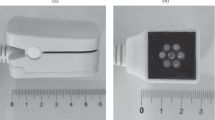Abstract.
We used photoplethysmography (PPG) to monitor blood flow changes in the human anterior tibial muscle during arterial occlusion and during isometric and concentric contractions. Single-fibre laser-Doppler flowmetry (LDF) was used as a reference in 12 healthy subjects (5 men, 7 women; mean age 24 years). Post-exercise hyperaemic muscle blood flow (MBF) was measured immediately after isometric dorsiflexion of the ankle joint at maximal contraction for 1 min and full range-of-motion dorsiflexion and plantar flexion of the ankle joint for 1 min. A thigh tourniquet was applied for the evaluation of post-occlusive reactive hyperaemia. The MBF (baseline=100%) was [mean (SD)] 150 (31)% (P=0.003) by PPG (880 nm) and 182 (66)% (P=0.012) by LDF. After 1 min of maximal isometric contraction, MBF increased to 150 (51)% (P=0.003) by PPG (880 nm) and to 169 (43)% (P=0.005) by LDF. After 1 min of maximal concentric contractions, MBF increased to 158 (59)% (P=0.003) by PPG (880 nm) and to 170 (99)% (P=0.008) by LDF. Skin blood flow, PPG (560 nm), did not change significantly after isometric or concentric contractions. The results indicate that reactive hyperaemia after exercise and arterial occlusion can be assessed in the human anterior tibial muscle using PPG.
Similar content being viewed by others
Author information
Authors and Affiliations
Additional information
Electronic Publication
Rights and permissions
About this article
Cite this article
Zhang, Q., Lindberg, LG., Kadefors, R. et al. A non-invasive measure of changes in blood flow in the human anterior tibial muscle. Eur J Appl Physiol 84, 448–452 (2001). https://doi.org/10.1007/s004210100413
Accepted:
Issue Date:
DOI: https://doi.org/10.1007/s004210100413




